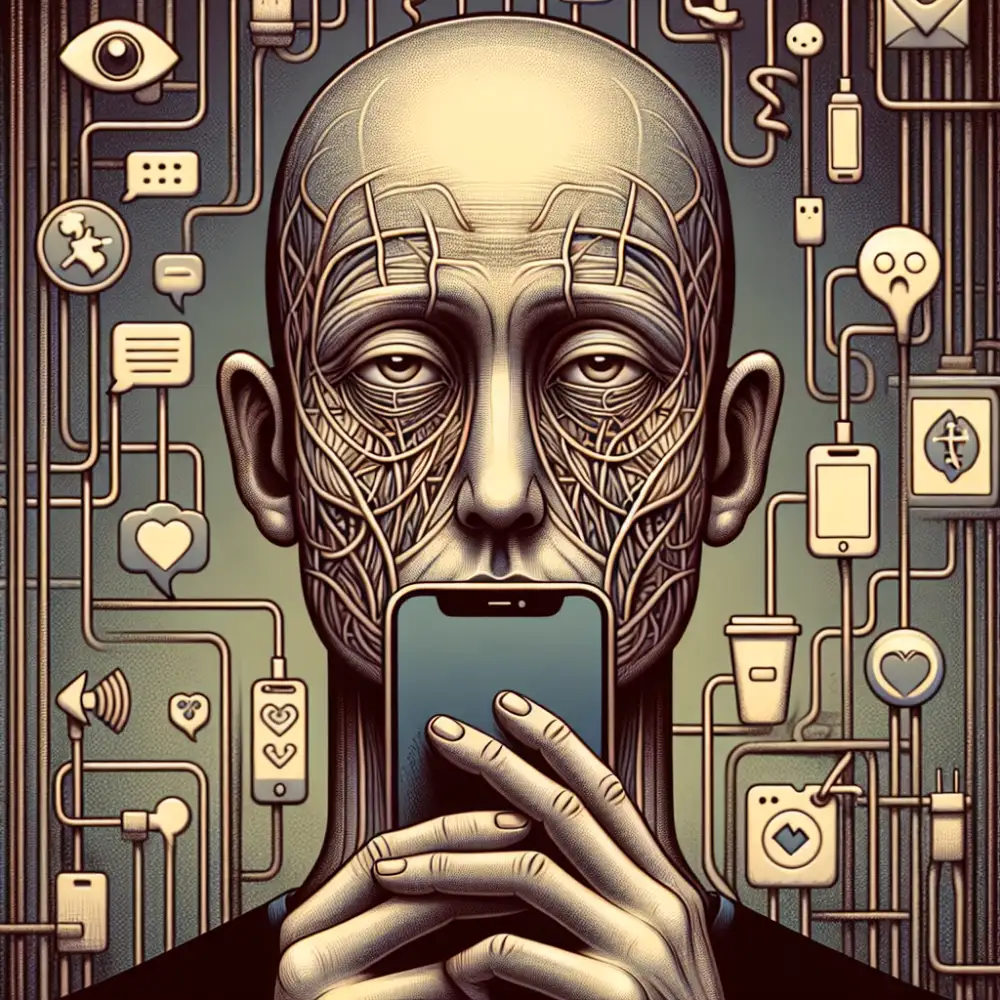Is Your Smartphone Giving You Smartphone Face?

Tech Neck
The pervasiveness of smartphones in our daily lives has undeniably revolutionized communication and access to information. However, this convenience comes with a potential downside, particularly concerning our physical health. One such concern that has gained attention is the phenomenon known as "tech neck." This condition encompasses a range of physical changes observed in individuals who spend prolonged periods hunched over their smartphones.
The human head, on average, weighs between 10 to 12 pounds. When we tilt our heads forward to look at our phones, the weight our neck muscles have to support increases significantly. This posture, over time, can lead to muscle strain, stiffness, and pain in the neck, shoulders, and upper back.
Beyond muscular issues, the repeated forward head posture associated with smartphone use can also impact the skeletal system. The spine, designed to maintain a natural curvature, can gradually lose its alignment with prolonged slouching. This can result in a condition known as "forward head posture," where the head protrudes forward relative to the shoulders.
The impact of "tech neck" extends beyond just aches and pains. Some individuals may experience headaches, particularly tension headaches originating from strained neck muscles. In more severe cases, there could be nerve compression, leading to numbness or tingling sensations in the arms and hands.
While "tech neck" is not a formally recognized medical diagnosis, it reflects a growing concern in the medical community about the physical consequences of our digital habits. Addressing this issue involves a multi-pronged approach.
Being mindful of our posture while using smartphones is crucial. Holding the phone at eye level, taking frequent breaks to stretch, and practicing exercises that strengthen the neck and back muscles can help mitigate the strain. Additionally, incorporating ergonomic accessories like phone stands and adjustable chairs can promote better posture.
"Tech neck" serves as a reminder that our digital habits can have real-world physical consequences. By understanding the risks and adopting preventive measures, we can continue to enjoy the benefits of technology without compromising our physical well-being.
Premature Aging
The constant staring, squinting, and frowning we subject our faces to while scrolling through social media or answering emails can contribute to premature aging. Think about it: every furrowed brow and squinted eye creates tiny creases in the skin. Over time, these creases deepen, turning into wrinkles and fine lines. It's like repeatedly folding a piece of paper – eventually, the fold becomes permanent.
Beyond expressions, the blue light emitted from our smartphones is a culprit in premature aging. Studies suggest that prolonged exposure to blue light can damage collagen and elastin, the proteins responsible for keeping our skin firm and elastic. This damage can lead to wrinkles, sagging, and uneven skin tone. Holding your phone close to your face can also cause tech neck, a condition characterized by wrinkles and sagging skin around the neck and jawline. The angle at which we typically hold our phones forces our necks to bend, leading to creases and wrinkles over time.

While we're not suggesting you swear off smartphones entirely, incorporating some simple habits can help minimize the risks. Try holding your phone at eye level to reduce neck strain and blue light exposure. Remember to take breaks from scrolling to relax your face and give your eyes a rest. And most importantly, prioritize a good skincare routine that includes sunscreen, antioxidants, and retinol to protect and repair your skin.
Facial Asymmetry
Facial asymmetry is a common condition where the two sides of the face differ in size, shape, or features. While some degree of asymmetry is normal, excessive smartphone use has been linked to an increase in facial asymmetry, particularly among young people.
Spending hours each day with your head tilted downward, staring at your smartphone screen, can put stress on the muscles and bones in your face and neck. This constant, unnatural posture can lead to a variety of issues, including:
Muscle imbalances: The muscles on one side of your neck may become shorter and tighter from constantly looking down, while the muscles on the opposite side may weaken. This imbalance can cause your head to tilt and your face to appear asymmetrical.
Jaw misalignment: The downward pressure on your jaw from constantly looking at your phone can strain your temporomandibular joint (TMJ) and lead to jaw pain, clicking, and even changes in the alignment of your jaw, contributing to facial asymmetry.
Bone remodeling: While less common in adults, prolonged poor posture during childhood and adolescence, when bones are still developing, can potentially influence the growth patterns of facial bones, leading to asymmetry over time.
It's important to note that research on the direct link between smartphone use and facial asymmetry is still ongoing. However, the potential risks associated with prolonged poor posture and repetitive strain from excessive smartphone use are significant enough to warrant attention.
To minimize the risk of smartphone-related facial asymmetry, consider these tips:
Mind your posture: Be mindful of how you hold your phone. Try to keep your head level and your shoulders relaxed.
Take breaks: Look up from your phone regularly to stretch your neck and give your eyes a break.
Limit screen time: Reduce your overall smartphone use and engage in activities that don't involve screens.
If you are concerned about facial asymmetry, consult with a healthcare professional or a qualified specialist like an orthodontist or a maxillofacial surgeon. They can help determine the underlying cause and recommend appropriate treatment options.

Jawline Issues
One modern phenomenon that's got people talking is "smartphone face," and a key part of this is the impact on our jawlines. Think about it: how often are you tilting your head down to look at your phone? It's practically second nature now. But all that downward gazing can lead to some not-so-desirable effects on our jawlines.
Here's the deal: when we constantly look down at our phones, we're putting extra strain on the muscles in our neck and jaw. This can cause them to shorten and tighten, leading to a less defined jawline. Ever heard of "tech neck"? It's a real thing, and it can contribute to that dreaded double chin appearance.
But it's not just about muscle strain. The way we hold our faces while glued to our phones can also play a role. Think about it: relaxed jaw, slightly open mouth – it's not exactly the most flattering pose. Over time, this can actually contribute to changes in the bone structure of our faces, potentially leading to a weaker, less defined jawline.
And let's not forget about the impact on our skin. All that time spent scrolling and texting means more pressure and friction on the delicate skin around our jawlines. This can lead to wrinkles, sagging, and a loss of elasticity – not exactly the recipe for a youthful, sculpted look.
Eye Strain and Wrinkles
While we scroll and tap away, our smartphones might be accelerating the hands of time on our faces. Constantly staring at our phones leads to eye strain, and all that squinting, frowning, and brow-furrowing can contribute to the formation of wrinkles over time. Think of it like folding a piece of paper repeatedly - eventually, the crease becomes permanent.
The skin around our eyes is particularly delicate and prone to showing signs of aging. When we strain to focus on our small screens, the muscles around our eyes contract, leading to those telltale crow's feet and forehead wrinkles. This effect is amplified by the blue light emitted from our devices, which some studies suggest can damage collagen and elastin, the proteins that keep our skin firm and youthful.
So, what can we do? Taking frequent breaks from our phones to focus on something at a distance can help relax those eye muscles. Adjusting the text size on your phone can also reduce eye strain. And, of course, a good skincare routine that includes sunscreen and products that boost collagen production can go a long way in preventing premature aging. Remember, your face is a reflection of your habits, and being mindful of your smartphone use can help you maintain a youthful and radiant appearance.
Reduced Physical Activity
The convenience of smartphones has revolutionized communication, information access, and entertainment. However, this convenience often comes at the cost of reduced physical activity. Spending hours hunched over a smartphone screen promotes a sedentary lifestyle. This can lead to muscle weakness and atrophy, particularly in the neck, shoulders, and back. The lack of movement also contributes to poor posture, further exacerbating the physical changes associated with "smartphone face." It's essential to prioritize physical activity to counteract these negative effects. Incorporate regular exercise into your routine, aiming for at least 30 minutes of moderate-intensity activity most days of the week. Simple changes like taking the stairs instead of the elevator or walking during phone calls can make a significant difference. Remember, a healthy balance between technology use and physical activity is crucial for overall well-being.

Published: 20. 06. 2024
Category: Food



